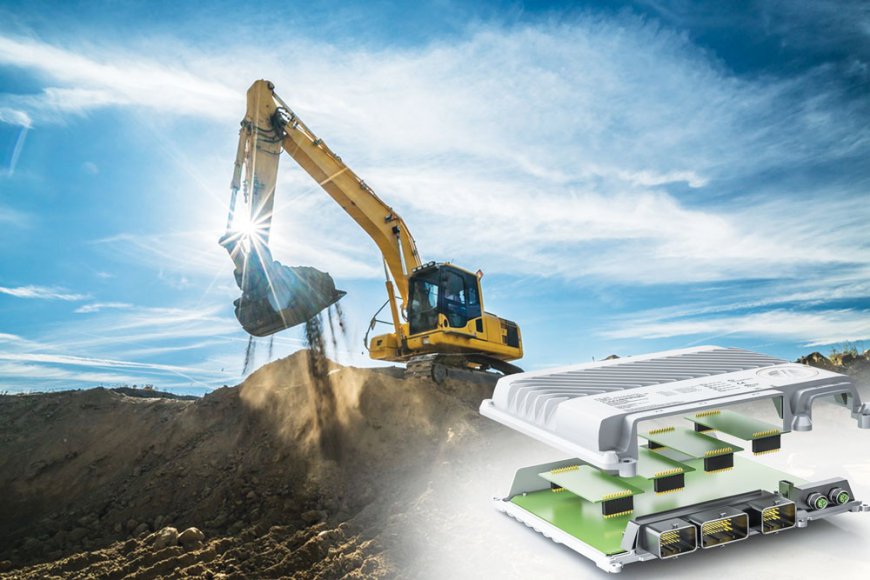Automation & Control Systems: Building Tomorrow, Today!

In the vast world of construction, where heavy machinery and intricate processes collide to shape our physical environment, there exists a silent revolution. It’s not just about the towering structures or the sprawling infrastructure; it’s about the invisible hands behind the scenes that are steadily transforming the landscape of construction. Enter automation and control systems – the unsung heroes of modern construction equipment, finds Equipment Times.
From towering cranes to mighty bulldozers, construction equipment has long been the backbone of large-scale projects. However, the traditional image of rugged machines operated by seasoned experts is rapidly evolving. In its place, a new era of efficiency, precision, and safety is emerging, driven by automation and control systems.
At the heart of this transformation lies the integration of cutting-edge technologies such as artificial intelligence, machine learning, and Internet of Things (IoT) into construction equipment. These advancements are not merely enhancements; they represent a paradigm shift in how construction sites operate and projects are executed.
One of the most notable advancements is the incorporation of autonomous features in construction machinery. Imagine a bulldozer that can navigate a construction site on its own, avoiding obstacles and adjusting its path in real-time. Such autonomous systems not only improve efficiency but also mitigate risks associated with human error, ultimately leading to safer work environments.
Moreover, automation and control systems are revolutionizing the way construction equipment is managed and maintained. Through predictive analytics and remote monitoring, equipment operators and managers can anticipate maintenance needs before they lead to costly downtimes. This proactive approach not only maximizes uptime but also extends the lifespan of machinery, yielding significant cost savings in the long run.
Safety is paramount in the construction industry, and automation plays a pivotal role in enhancing workplace safety. With features like collision avoidance systems and remote operation capabilities, construction equipment can minimize the risk of accidents and injuries, safeguarding both workers and assets.
Furthermore, the integration of control systems enables precise and efficient operation of machinery, resulting in higher productivity and reduced resource consumption. Whether it’s optimizing fuel usage in excavators or fine-tuning concrete pouring with unprecedented accuracy, these systems empower construction companies to achieve more with less, thereby promoting sustainability in the industry.
However, amidst the excitement surrounding automation and control systems, challenges persist. Concerns regarding data security, interoperability among different equipment, and the need for specialized training for operators are among the hurdles that need to be addressed. Additionally, there is a growing debate about the potential impact of automation on employment in the construction sector, highlighting the importance of reskilling and workforce development initiatives.
Nevertheless, the benefits far outweigh the challenges, as automation and control systems continue to redefine the possibilities in construction equipment. As technology evolves and becomes more accessible, the democratization of these advancements will empower construction companies of all sizes to embrace innovation and thrive in an increasingly competitive landscape.
Market
The market for automation and control system products used in construction equipment is experiencing significant growth and innovation. These systems play a crucial role in enhancing the efficiency, safety, and productivity of construction machinery. Here are some key aspects of this market:
• Increased Efficiency: Automation and control systems help construction equipment operate more efficiently by optimizing performance parameters such as fuel consumption, engine power, and hydraulic systems. This leads to cost savings for construction companies through reduced fuel usage and increased machine uptime.
• Safety Improvements: Advanced control systems incorporate safety features such as collision avoidance, object detection, and operator assistance systems. These technologies help prevent accidents on construction sites, reducing injuries and fatalities.
• Remote Monitoring and Telematics: Many modern construction equipment manufacturers offer telematics solutions that enable remote monitoring of machines in real-time. These systems provide valuable data on equipment usage, health, and performance, allowing fleet managers to optimize operations and schedule maintenance proactively.
• Integration with IoT and AI: Automation and control systems are increasingly integrated with Internet of Things (IoT) devices and artificial intelligence (AI) algorithms. This integration enables predictive maintenance, autonomous operation, and data-driven decision-making in construction equipment management.
• Regulatory Compliance: Stringent environmental regulations and emissions standards are driving the adoption of advanced control systems in construction equipment. Manufacturers are investing in technologies such as engine emissions control and idle-reduction systems to comply with these regulations.
• Market Growth: The market for automation and control systems in construction equipment is expected to continue growing as construction companies seek ways to improve productivity, safety, and sustainability. Emerging technologies such as electrification, autonomous operation, and machine learning are further driving innovation in this sector.
• Competition and Collaboration: Competition among equipment manufacturers and technology providers is intensifying as they strive to develop cutting-edge automation and control solutions. Additionally, collaborations between construction companies, technology firms, and research institutions are fostering innovation and driving the adoption of new technologies in the industry.
Overall, the market for automation and control system products used in construction equipment is dynamic and evolving rapidly, driven by technological advancements, regulatory requirements, and the demand for improved efficiency and safety in construction operations. In conclusion, the era of automation and control systems in construction equipment represents not just a technological evolution but a fundamental shift in how we build the world around us. It’s a testament to human ingenuity and our relentless pursuit of progress. As we navigate towards a future where construction sites are safer, more efficient, and environmentally sustainable, one thing is certain – the revolution has only just begun.
Sector Buzz…

Raghavendra Borelli, Local Business Unit – Sales Director (Bangalore & Chennai Region), B&R Automation said, “Industrial automation systems rely heavily on effective connectivity as a foundational element. This connectivity facilitates the gathering of crucial data necessary for controlling machinery and processes, monitoring, conducting analyses, and implementing necessary adjustments. Here, IO-Link plays an important role as an open communication standard for connecting sensors and actuators. It simplifies the integration to any new or existing system and makes it flexible for the future. As today’s sensors become more intelligent by adopting digital parameter sets, To streamline connectivity and reduce cabling, B&R now enables direct linkage of these smart sensors to IO-Link. Here, IO-Link replaces all kinds of analog, digital and hybrid interfaces with one standardized interface. B&R has also introduced a new 8-channel X67 IO-Link Master, which integrates seamlessly on the distributed backplane in the existing machine architecture and can also be integrated into the fieldbus. This highly modular B&R solution helps OEMs drastically improve performance and fully leverage data from smart sensors, while at the same time reducing hardware costs and saving valuable space in the machine.”
He further added, “Modern processes and emerging technologies are of great interest to machine builders, and construction businesses worldwide are seeking new ways to improve their operations by embracing innovative ideas and engaging with new approaches. But there seems to be quite a gap in understanding the technology and choosing the right one to benefit their businesses. As per reports there are few key innovative emerging trends determined for the productivity of sector and that includes sustainable construction practices. With recent construction industry forums, we have witnessed machine manufacturers inclination towards adapting to innovations but determining a right channel towards building a strong background needs a strong partner and construction industry erudite. Recognizing this need, we at B&R have embarked on a journey to empower machine builders with the knowledge and proficiency needed to thrive in an era defined by cutting-edge automation. Through strategic collaborations and training initiatives, we aim to equip our partners with the skills necessary to navigate the ever-evolving landscape of construction technology with confidence and finesse.”

Samip Desai, Director, MOBA Mobile Automation (India), said, “MOBA offers a comprehensive range of automation solutions, catering to a wide spectrum of machinery used in the construction industry, such as asphalt pavers, compactors, motor graders, diesel bowsers, tippers, dumpers, and more. For instance, in the case of asphalt pavers, our offerings span from basic grade and slope sensors to advanced technologies like the big sonic ski, also known as an averaging system. These systems play a crucial role in ensuring the creation of smooth roads, contributing to the infrastructure development of nations. Machine control systems significantly enhance efficiency, safety, and overall performance across various construction equipment. In pavers, they ensure precise material placement, reducing waste and improving surface quality. Graders benefit from automated blade control, achieving accurate grading with minimal rework. Excavators equipped with these systems increase productivity through precise digging and material handling, while soil compactors maintain uniform compaction, enhancing stability and durability of structures. These systems minimize operator errors, leading to safer operations, and optimize workflow, ultimately resulting in faster project completion and higher-quality outcomes in construction projects. We value collaboration to continuously improve our automation and control systems. We have engaged in partnerships and collaborations with various companies and organizations to leverage collective expertise, broaden perspectives, and enhance the capabilities of our systems. These collaborations have enabled us to integrate innovative technologies, address industry challenges, and deliver more comprehensive solutions to our customers.”








